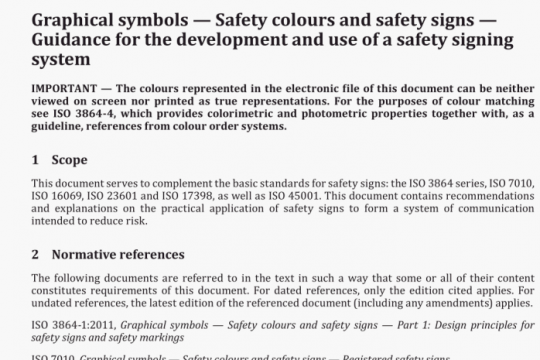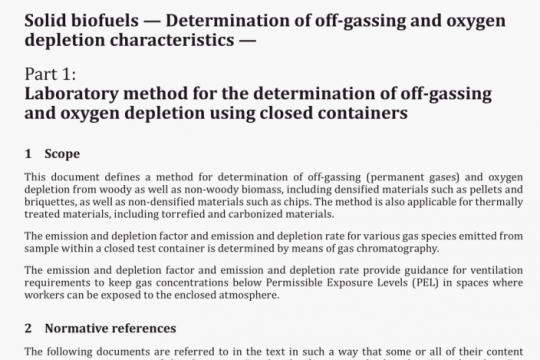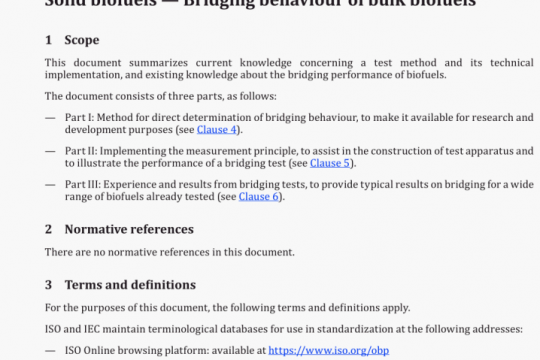ISO 6571 pdf free download
ISO 6571-2008 pdf free download.Spices, condiments and herbs – Determination of volatile oil content (hydrodistillation method).
6.2 Filter paper, of diameter 110 mm.
6.3 PIpette, of capacity 1 ml.
6.4 Heating device.
The method of heating should be such as to avoid overheating of the flask (6.1.1). A device for regulating the temperature is recommended.
6.5 Anti-bumping granules or glass beads.
6.6 Measuring cylinder, of capacity 500 ml.
6.7 Analytical balance.
7 Sampling
A representative sample should have been sent to the laboratory. It should not have been damaged or changed during transport or storage.
Sampling is not part of the method specified in this International Standard. A recommended sampling method is given in ISO 948L1.
8 Procedure
NOTE It is intended to specify the test parameters in the International Standard specifying requirements for each sp*ce or condiment. In the meantime, these parameters are given m Annex A.
8.1 Preparation of the apparatus
Carefully clean the condenser system (6.1.2). Tightly fix the glass stopper (K’) on the side-arm (K) and the steam trap (6.1.3) on the safety tube (N). Turn the apparatus upside down, fill it with the cleaning solution (5.2) and leave it in this position overnight. Rinse the apparatus very carefully with water after having cleaned it.
8.2 Preparation of the test sample
If the test portion has to be ground (see Annex A), crush a sufficient quantity of the laboratory sample just before adding to the round-bottom flask to a suitable degree of fineness according to the product concerned (see ISO 2825). During the crushing procedure, ensure that the temperature of the test portion does not rise.
The mesh size of the sample shall be stated in each International Standard relating to a given spice.
8.3 Test portion
Weigh, to the nearest 0,01 g, on the filter paper (6.2), the specified quantity of test sample (see Annex A).
8.4 Determination
8.4.1 Determination of the volume of xylene
Using the measuring cylinder (6.6), transfer the specified quantity of water (see Annex A) to the flask (6.1.1) and add the anti-bumping granules or glass beads (6.5). Connect the flask to the condenser system (6.1.2) and fill the tube graduated in divisions of 0,05 ml (JL), the collector bulb (L) and the inclined tube (0) with water through the side-arm (K). Using the pipette (6.3), add 1 ml of the xlene (5.1) through the side-arm. Half fill the steam trap (6.1.3) with water and connect it to the condenser system. Heat the flask and regulate the rate of distillation to 2 mI/mm or 3 mI/mm unless otherwise specified. Distil for about 30 mm and then remove the source of heat (6.4). By means of the three-way tap (M), allow the xylene to flow into the tube (JL) in such a way that the upper level coincides with the zero mark. Allow to cool for at least 10 mm and measure the volume of xylene.
8.4.2 DetermInation of volume of organic phase (volatile oil and xylene)
Transfer the filter paper (6.2) with the test portion (8.3) to the flask (6.1.1). and again connect the flask to the condenser system. Heat the flask and regulate the rate of distillation to 2 mI/mm or 3 mI/mm unless otherwise specified. Allow the distillation to continue for the specified time (see Annex A). (Record the distillation time for inclusion in the test report.)
Remove the source of heat (6.4) and allow to cool. After 10 mm, read the volume of the organic phase (mixture of volatile oil and xylene) collected in the measurement tube.
8.4.3 Determination of moisture content
Determine the moisture content by the method specified in ISO 939.
9 Expression of results
The volatile oil content, w, expressed in millilitres per 100 g of dry product, is given by the following equation:
where
is the volume, in millilitres, of xylene measured in 8.4.1;
is the total volume, in millilitres, of volatile oil and xylene measured in 8.4.2;
in is the mass, in grams, of the test portion;
“H20 is the moisture content, expressed as a percentage mass fraction, determined in 8.4.3.
10 Precision
Details of an interlaboratory trial on the precision of the method are summarized in Annex B. The values derived from this interlaboratory test may not be applicable to concentration ranges and matrices other than those given.ISO 6571 pdf download.




